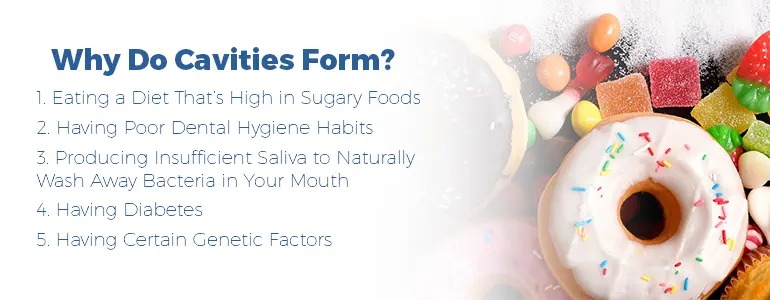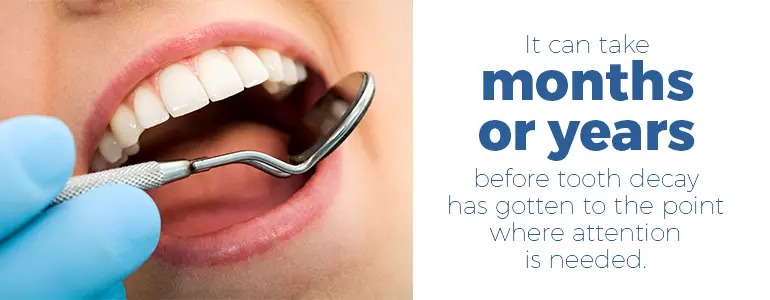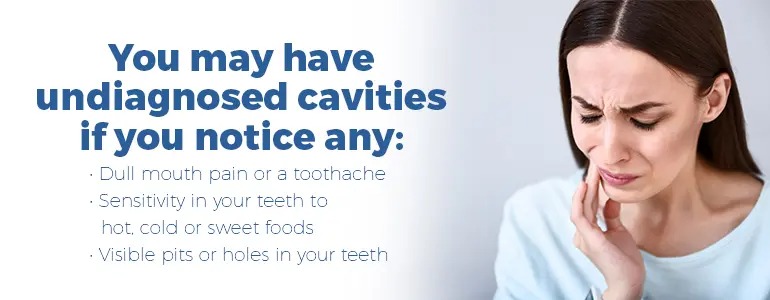
When you go to your dentist for a dental cleaning or a checkup, four words you undoubtedly dread to hear is “you have a cavity.” No one wants to have a cavity, but the fact is that just about all adults in the U.S. have tooth decay, according to a government survey, and over a quarter of them have untreated cavities.
The Centers for Disease Control and Prevention (CDC) states that even though over the past few decades there has been a decline in tooth decay and tooth loss, 91 percent of American adults’ aged 20 to 64 have cavities in their permanent teeth.
How do cavities form, and what can you do to avoid them? We’ll shed light on the answers to these questions and more below.
Your mouth is chock-full of bacteria. It’s just a normal part of life. When these bacteria get to a point where they begin destroying areas of your tooth, a dental cary, better known as a cavity, forms. A cavity typically starts out on your tooth enamel as a tiny area, but it will eventually eat through your enamel and tooth structure if left untreated.
Everyone gets plaque on their teeth. Plaque is a sticky substance in which bacteria thrive. When your saliva doesn’t wash this plaque away or if you don’t brush it off after you eat, it eats up the sugar from the food you eat. This produces acid that can’t be easily washed away by your saliva. This acid then begins dissolving the minerals that harden your tooth enamel, making it penetrable and creating tiny holes.
To put simply:
With time, this acid creates a tiny hole in your enamel. Eventually, that whole gets bigger and forms a cavity. If left untreated, the cavity can extend to the nerve of your tooth and become infected and painful. It can even destroy your entire tooth structure, which can require you getting a tooth removed and putting a dental implant in its place.

There are certain factors that increase your risk of developing tooth decay and cavities. These are:
Eating a Diet That’s High in Sugary Foods
Eating a diet that’s high in sugary foods is a big risk factor for developing cavities. When acid frequently penetrates your tooth because you consume foods or drinks high in sugar
and starch often, the acid continues to attack your enamel and can cause it to lose its minerals.
Having Poor Dental Hygiene
If you don’t brush and floss your teeth twice a day or visit your dentist every six months, you increase your risk of having cavities form.
Producing Insufficient Saliva to Naturally Wash Away Bacteria in Your Mouth
The saliva in your mouth helps keep plaque from building up on your teeth by washing away food particles. When you have a dry mouth or low salivary flow, whether it’s due to
genetics, a medical condition or medications you’re taking, your teeth are more susceptible to decay.
Having Diabetes
When you have uncontrolled diabetes, it takes a toll on your body, including your gums and teeth. You have a higher risk of cavities as your blood sugar level increases because you
have more starches and sugars that interact with the plaque on your teeth, develop into acids and wear away at your teeth enamel.
Having Certain Genetic Factors
Genetic factors also play a big role in your risk of developing tooth decay. These genetic factors may include:
Tooth shape and size.
If you have small teeth that have numerous grooves and deep pits, they are more susceptible to the formation of cavities than larger teeth with shallower and fewer grooves. Grooves in your teeth enamel make it difficult to brush thoroughly, allowing plaque to build up.
Your enamel defends your teeth against cavities, so the thicker your enamel is, the longer a cavity takes to penetrate through your tooth.
When you have overlapped and crooked teeth, it gives the plaque more areas to build up. Crooked teeth are also harder to clean. A poor bite can cause the enamel to wear down quickly on your teeth and leave soft dentin exposed. This is why braces are a good cavity-prevention measure. Braces and aligners straighten your teeth and place them in correct alignment.
Children have a higher risk of getting cavities when their permanent teeth come in early in life since they may not have developed good oral hygiene practices yet.

How fast does a cavity form? Thankfully, cavities don’t form overnight. It’s a gradual process and can take months, or sometimes years before tooth decay has gotten to the point where attention is needed. But when an acidic oral environment is present, it can cause tooth demineralization and the formation of a cavity.
Cavities form more quickly in children than in adults. The enamel in children’s teeth is weaker than adult teeth, making them more susceptible to cavities. A cavity can form in a child’s tooth in a few months, whereas it can take up to 12 months for a cavity to form in an adult.
So, how quick a cavity forms is essentially up to you. With proper dental hygiene and frequent visits to the dentist, you may never have a cavity.
Once you get a cavity that penetrates deep within your tooth, it can make your mouth sensitive to hot, cold or sweet foods. After a while, it will likely cause pain, known as a toothache.
This is why it’s important to have your Sun City West, AZ dentist examine your teeth every six months. You might be unable to detect cavities, but your dentist can find them in your regular dental exam. However, early signs of tooth decay can be missed, even by your dentist, which is why it’s essential to point out any other abnormality in your teeth to your dentist.
Obviously, if your front teeth have cavities, they’ll be easier to spot. Cavities are typically a brownish spot and are where the structure of your tooth has become soft because of the acid-attacking bacteria. If the spot is light brown, that usually indicates a cavity that is fast growing. Darker brown is a cavity that is typically growing slower. If the cavity gets big enough, it can leave a whole in the tooth or even cause the tooth to break

You may have undiagnosed cavities if you notice any:
These symptoms can indicate one or more cavities in your teeth, which you should get treated by your dentist right away. Your dentist can treat the cavities easily in the initial stages by drilling the hole and filling it with a resin or other metal material. Identifying cavities and getting them treated early is key to preserving your teeth and the health of your mouth.
Proper dental and oral hygiene is important to prevent tooth decay and cavities. Some steps you can take to keep your teeth and mouth healthy are:
Ask your dentist which tips are best for you. How long it takes cavities to form is often about how well you take care of your teeth, but sometimes, they may form no matter what you do. Therefore, regular dental exams are essential.

Since the early stages of cavities often arise with no symptoms, you have to rely on your dental visits for a thorough cleaning and examination. If trouble spots are located, they need to be treated immediately before a bigger problem arises. If you experience any sensitivity or tooth pain, call your dentist.
Regular dental visits are key to catching cavities in their tracks and treating them before they grow bigger. Don’t ignore smaller cavities since they can quickly turn into you needing a root canal, crown, or dental implant. The more the cavity grows, the more tooth structure you lose, which can lead to a higher risk of recurrent decay, fractured teeth, and tooth loss.
Don’t let your next question be, “How do I get rid of a cavity?” Reach out to our Arizona dentists at AZ Family Dental for a dental exam and consultation.